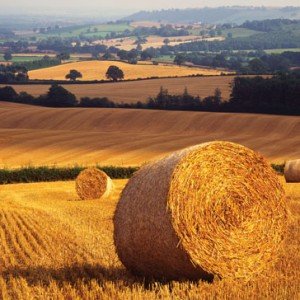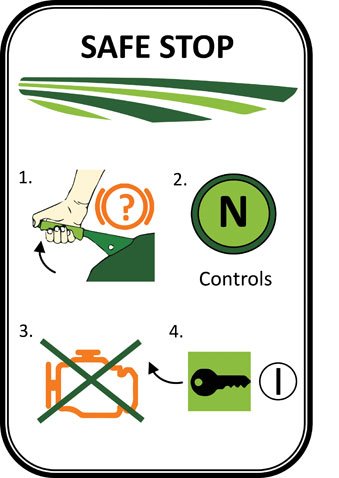Bale handling is carried out throughout the year on farms, but with baling in full swing, now is a good time to consider the consequences of ‘rushing the job’, warns Alan Plom.
 Some large bales of straw, hay or silage can literally ‘weigh a ton’ but although the crushing hazard should be obvious, incidents involving falling bales are not uncommon.
Some large bales of straw, hay or silage can literally ‘weigh a ton’ but although the crushing hazard should be obvious, incidents involving falling bales are not uncommon.
At least 18 deaths have been caused by falling bales in agriculture since 2000. Many more have been injured, but the total number is unknown due to significant under-reporting in the industry.
Farmers and their workers need to be more vigilant and should review their systems for storage, handling and training to avoid further tragedies. Incidents occur in the field during baling and transport, through to their storage and subsequent de-stacking and handling, for example, for bedding or feeding animals.
A significant hazard during baling is clearing blockages without following the ‘safe stop’ procedure (see figure 1). [1]
However, discharging and leaving bales in fields is not without its dangers.
Large round bales have rolled down slopes — one even caused the death of a passing motorist. Children (or adults) can play on them or attempt to move them, so bales must be stacked safely, in fields, farmyards or buildings.
Incidents also occur regularly during transportation, for example, contacting overhead power lines when being moved using telehandlers or falling from trailers during transportation or unloading, which is why training in transporting and securing loads is so important.
The dangers of unsafe storage and de-stacking were highlighted earlier in the year by two HSE prosecutions. A pig producer was fined £16,000 and £4,500 costs after a part-time worker suffered multiple fractures to his spine and ribs. Two large straw bales toppled and bounced down the arm of the loader he was using to remove bales from an excessively high stack. The loader did not have its protective structure fitted. [2]
A month later, a horse breeder was prosecuted for a similar accident in which a 20-year-old veterinary student suffered severe injuries when she was struck by four large straw bales, weighing more than 1.2 tonnes, on her last day of work experience. [3]

Once again, the bales toppled from a high (5.5m) stack. One was lifted off her back using a telehandler but another trapping her leg had to be cut into pieces and removed by hand because she was in so much pain.
She suffered multiple injuries, including a broken pelvis, right leg and ankle. Although she is walking again after three months in a wheelchair and having had physiotherapy, her mobility has been severely affected and she may need an ankle replacement. The consequences of this avoidable accident on this young lady’s career have been devastating.
The partner who ran the stud farm was fined £10,000 with £10,000+ costs after pleading guilty to a breach of regulation 10(4) of the Work at Height Regulations 2005. This requires materials and objects to be stored in such a way as to prevent risk to any person arising from collapse, overturning or unintended movement.
There have been a number of other similar cases over recent years, including a Leicestershire farmer fined £20,000 and £5,000 costs in February 2011 after his friend was killed by three plastic-wrapped round silage bales that fell from an unstable stack because they were not removed in reverse order to which they were stacked.
To reiterate what HSE’s investigating inspector said at the time: “This death shows how easy it is for an everyday activity on a farm to lead to tragedy”. This really is the most important point to stress. This is an everyday activity at many thousands of farms across the UK, so the potential for serious incidents in the future is very high.
Age (and assumed experience) appears to be no barrier (or help) either. For example, in 2007, a 70-year-old self-employed farmer was killed by hay bales that fell as he was unloading a trailer. Three days later a 21-year-old was paralysed by a falling silage bale when his bale grab failed. He shared his experience as a warning to others in one of the short ‘Make The Promise’ films available on HSE’s website. [4]
The risk can be reduced by taking the precautions in HSE’s leaflet Safe working with bales in agriculture (INDG 125). [5] This describes in simple terms where and how to stack bales safely, maintenance of stacks and de-stacking, as well as transporting bales. It also includes a useful checklist and deals with traditional ‘small’ bales, which although much lighter, have also been involved in many fatalities and serious injuries over the years.
All farmers and farm workers would be strongly advised to watch this film and read HSE’s guidance on straw bales. Together, they should remind anyone working with bales of the simple but critical steps they should take, to avoid a similar tragedy happening to themselves, members of their family, employees or friends.
References
1. More information on ‘Safe Stop’ and the industry-led Farm Safety Partnership.
2. http://www.iosh.co.uk/en/Membership/Our-membership-network/Our-Groups/Rural-Industries-group/Group-news/Pig-Farmers-fined-after-worker-crushed.aspx
3. http://press.hse.gov.uk/2014/life-changing-injuries-cloud-trainee-vets-ambitions/
4. Farmer paralysed by bale film
5. Safe working with bales in agriculture HSE leaflet
Alan Plom is chair of the industry’s Farm Safety Partnership’s Machinery Safety Group and vice-chair of IOSH’s Rural Industries Group
Approaches to managing the risks associated Musculoskeletal disorders
In this episode of the Safety & Health Podcast, we hear from Matt Birtles, Principal Ergonomics Consultant at HSE’s Science and Research Centre, about the different approaches to managing the risks associated with Musculoskeletal disorders.
Matt, an ergonomics and human factors expert, shares his thoughts on why MSDs are important, the various prevalent rates across the UK, what you can do within your own organisation and the Risk Management process surrounding MSD’s.

 Some large bales of straw, hay or silage can literally ‘weigh a ton’ but although the crushing hazard should be obvious, incidents involving falling bales are not uncommon.
Some large bales of straw, hay or silage can literally ‘weigh a ton’ but although the crushing hazard should be obvious, incidents involving falling bales are not uncommon.
